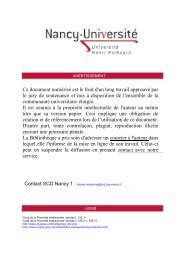Ce document numérisé est le fruit d'un long travail approuvé par le ...
Ce document numérisé est le fruit d'un long travail approuvé par le ...
Ce document numérisé est le fruit d'un long travail approuvé par le ...
Create successful ePaper yourself
Turn your PDF publications into a flip-book with our unique Google optimized e-Paper software.
610 Huin, Carriveau, Bianchi, Kel<strong>le</strong>r, Col<strong>le</strong>t, Krémarik-Bauillaud, Damenjaud, Bécuwe, Schahn, Ménard, Dauça<br />
than in duodenum. The different spatiotemporal expression<br />
of PPARŒ, PPAR[3, and PPAR'Y during development<br />
of the human fetal int<strong>est</strong>ine and their ligand<br />
specificity (S0rensen et al. 1998) sugg<strong>est</strong> that these receptors<br />
are involved in different int<strong>est</strong>inal functions.<br />
PPARΠligands induce the expression of genes involved<br />
in lipid absorption and transport in the rat<br />
small int<strong>est</strong>ine (Martin et al. 1997; Motojima et al.<br />
1998). The physiological raIe of PPAR[3 in the small<br />
and large int<strong>est</strong>ine remains unknown. PPAR'Y ligands<br />
have been shown to inhibit proliferation and to induce<br />
differentiation of human colon cancer cells (Brockman<br />
et al. 1998; Sarraf et al. 1998). On the other hand, the<br />
same ligands enhance colon polyp and tumor formation<br />
in the min!+ mouse model (Lefebvre et al. 1998;<br />
Saez et al. 1998). It is evident fram our results that<br />
PPAR'Y is expressed a<strong>long</strong> the int<strong>est</strong>inal crypt-villous<br />
region in both proliferating and differentiated cells. At<br />
present, it is difficult to speculate about the precise<br />
raIe played by PPAR'Y in int<strong>est</strong>inal celliife.<br />
In summary, the spatiotemporal distribution of the<br />
PPAR subtypes has been described during development<br />
of the human fetal dig<strong>est</strong>ive tract. The different<br />
ppARs are predominantly expressed in epithelial cells,<br />
although their presence is also detected in nuc<strong>le</strong>i of<br />
cells of mesodermal origin. The three PPAR subtypes<br />
exhibit different patterns of expression in relation to<br />
the morphogenesis of the dig<strong>est</strong>ive tract. They are expressed<br />
very early, sugg<strong>est</strong>ing that these receptors play<br />
major raIes in the development and/or the physiology<br />
of the dig<strong>est</strong>ive tract. Furthermore, the fact that PPAR'Y<br />
is expressed at a high <strong>le</strong>vel whatever the region considered<br />
(except the stomach) and the stage studied argues<br />
for a prominent ro<strong>le</strong> of this receptor in human dig<strong>est</strong>ive<br />
tract.<br />
Acknow<strong>le</strong>dgments<br />
Supported by the Association de la Recherche contre <strong>le</strong><br />
Cancer (Contrat ARC no. 9233), the Ligue contre <strong>le</strong> Cancer<br />
(Comité de Meuthe et Mosel<strong>le</strong>), the Fondation de la Recherche<br />
Médica<strong>le</strong> (Comité de Lorraine), and the Conseil de Recherches<br />
Médica<strong>le</strong>s du Canada.<br />
We are grateful to W. Wahli (University of Lausanne) for<br />
the mPPARO'/pSGS, mPPARl3!pSG5, mPPAR'Yl/PSGS, and<br />
hPPAR'Yz/pBSIIKS+ plasmids, to M. Donner (UPRES 2402,<br />
Nancy) for the 3T3 L1 cells, and to A. Stoekel for her skillfui<br />
assistance.<br />
Literature Cited<br />
Auboeuf D, Rieusset J, Fajas L, Vallier P, Freing V, Riou JP, Lavil<strong>le</strong><br />
M, Staels B, Auwerx J, Vidal H (1997) Tissue distribution and<br />
quantification of the expression of peroxisome proliferator-activated<br />
receptors and liver X recepror-alpha in humans: no alteration<br />
in adipose tissue of obese and NIDDM patients. Diabetes<br />
46:1319-1327<br />
Avrameas S (1969) Coupling of enzymes to protein with glutaraldehyde.<br />
Use of the conjugates for the detection of antigens and antibodies.<br />
Immunochemistry 6:43-52<br />
Basque JR, Levy E, Beaulieu JF, Ménard D (1998) Apolipoproteins<br />
in human fetal colon: immunolocalization, biogenesis, and hormonal<br />
regulation. J <strong>Ce</strong>ll Biochem 7Q:354-365<br />
Bradford MM (1976) A rapid and sensitive method for the quantification<br />
of microgram quantities of protein urilizing the princip<strong>le</strong>dye<br />
binding. Anal Biochem 72:248-254<br />
Braissant 0, Foufel<strong>le</strong> F, Scotto C, Dauça M, Wahli W (1996) Differentiai<br />
expression of peroxisome proliferator-activated receprors<br />
(PPARs): tissue distribution of PPAR-a, -13, and --y in the adult<br />
rat. Endocrinology 137:354-366<br />
Braissant 0, Wahli W (1998) DifferentiaI expression of peroxisome<br />
proliferator-activated receptor -a, -13, --y during rat embryonic<br />
development. Endocrinology 139:2748-2754<br />
Brockman JA, Gupta RA, Dubois RN (1998) Activation of PPAR-y<br />
<strong>le</strong>ads to inhibition of anchorage-independent growth of human<br />
colorectal cancer cells. Gastroenterology 115:1049-1055<br />
Chawla A, Schwarz EJ, Dimaculangan DD, Lazar MA (1994) Peroxisome<br />
proliferator-activated receptor (PPAR) gamma: adiposepredominant<br />
expression and induction early in adipocyte differentiation.<br />
Endocrinology 135:798-800<br />
Chomzynski P, Sacchi N (1987) Sing<strong>le</strong>-step method of RNA isolation<br />
by acid guanidium thiocyanate-phenol-chloroform extraction.<br />
Anal Biochem 162:156-159<br />
Dauça M, Cablé S, Calvert R, Colin S, Schilt J, Leheup B, Kel<strong>le</strong>r JM,<br />
Ménard D (1996) Peroxisomes and peroxisomal enzymes in the<br />
human fetal small int<strong>est</strong>ine. Biol Neonate 69:12-21<br />
De Lomos (1977) The ultrastructure of endocrine cells in the corpus<br />
of the stomach of human fetuses. Am J Anat 148:359-384<br />
Desvergne B, Wahli W (1995) PPAR: a key nuc<strong>le</strong>ar factor in nutrient/gene<br />
interactions? In Baeuer<strong>le</strong> P, ed. Inducib<strong>le</strong> Transcription.<br />
Vol 1. Boston, Birkhaüsser, 142-176<br />
Dubois RN, Gupta R, Brockman J, Reddy BS, Krakow SL, Lazar<br />
MA (1998) The nuc<strong>le</strong>ar eicosanoid receptor, PPAR-y, is aberrantly<br />
expressed in colonic cancers. Cancerogenesis 19:49-53<br />
Elbrecht A, Chen Y, Cullinan CA, Hayes N, Leibowitz MD, Mol<strong>le</strong>r<br />
DE, Berger J (1996) Mo<strong>le</strong>cular cloning, expression and characterization<br />
of human peroxisome proliferator activated receptors<br />
-YI and -Y2. Biochem Biophys Res Commun 224:431-437<br />
Fajas L, Auboeuf D, Raspe E, Schoonjans K, Lefebvre AM, Saladin<br />
R, Najib J, Fruchart JC, Deeb S, Vidal-Puig A, Plier J, Briggs<br />
MR, Staels B, Vidal H, Auwerx J (1997) The organisation, promoter<br />
analysis, and expression of the human PPAR gamma gene.<br />
J Biol Chem 272:18779-18789<br />
Fajas L, Fruchart JC, AuwerxJ (1998) PPARgamma3 mRNA: a distinct<br />
PPARgamma mRNA subtype transcribed from an independent<br />
promoter. FEBS Lett 438:55-60<br />
Johns BAE (1952) Dev~lopmental changes in the oesophageal epithelium<br />
in man. J Anat 86:431-442<br />
Lee SS, Pineau T, Drago J, Lee EJ, Owens JW, Kroetz DL, Fernandez-Salguero<br />
PM, W<strong>est</strong>phal H, Gonza<strong>le</strong>z FJ (1995) Targeted disruption<br />
of the Ct isoform of the peroxisome proliferator-activated<br />
receptor gene in mice results in abolishment of the p<strong>le</strong>iotropic effects<br />
of peroxisome proliferators. Mol <strong>Ce</strong>ll Biol 15:3012-3022<br />
Lefebvre AM, Chen l, Desreumeaux P, Najib J, Fruchart JC, Geboes<br />
K, Heyman R, Auwerx J (1998) Activation of the peroxisome<br />
proliferator-activated receptor -y enhances the development of<br />
colon cancer tumors in C57BLl6J-APCmin/+ mice. Nature Med<br />
4:1053-1057<br />
Lemberger T, Desvergne B, Wahli W (1996) Peroxisome proliferator-activated<br />
receptors: a nuc<strong>le</strong>ar receptor signaling pathway in<br />
lipid physiology. Annu Rev <strong>Ce</strong>ll Dev Biol 12:335-363<br />
Levy E, Thibault L, Ménard D (1992) Int<strong>est</strong>inallipids and lipoproteins<br />
in the human fetus: modulation by epidermal growth factor.<br />
J Lipid Res 33:1607-1617<br />
Mansen A, Guardiola-Diaz H, Rafter j, Branting C, Gustafsson jA<br />
(1996) Expression of the peroxisome proliferator-activated receptor<br />
(PPAR) in the mouse colonic mucosa. Biochem Biophys<br />
Res Commun 222:844-851<br />
Martin G, Schoonjans K, Lefebvre AM, Staels B, Auwerx J (1997)<br />
Coordinate regulation of the expression of the fatty acid transport<br />
protein and acyl-CoA synthetase genes by PPARa and<br />
PPAR-y activators. j Biol Chem 272:28210-28217
















